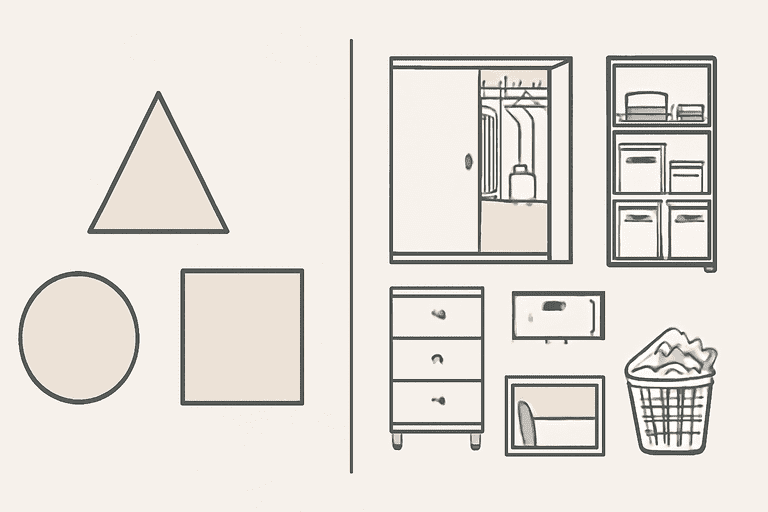To be honest, I’m a lazy person—not only do I hate doing housework, but I also daydream about my home magically tidying itself. Hiring a cleaner is out of the question (because, well, I’m broke). So my goal with minimalism has always been simple: reduce the amount of housework. I want to maintain a clean and cozy home with just a tiny bit of effort.
Over the past three years of practicing minimalism, I’ve realized that the key to minimizing housework is actually reducing the number of possessions. Sounds easy, but it’s surprisingly hard to do. That’s why I’ve kept writing about minimalism.
Recently, I came across two books that introduced 3 core principles and 7 daily habits that I found both practical and refreshingly new. In this post, I’ll break them down for you through the lens of my own experience—hoping it helps fellow lazy folks like me.
The 3 Core Principles of Organizing
1. The “3-to-1” Rule
This means limiting your choices to no more than three options. Doing so helps reduce decision fatigue and frees up your mental energy, allowing you to focus on what truly matters in the moment.
In my previous post, Minimalism | Quantifying Your Life: A Shortcut to Less, I talked about the power of reducing choices and how I apply it to my wardrobe. The “3-to-1” rule might sound a bit extreme at first—but in daily life, we can go even further.
Take scissors, for example. I live alone, and I only own one pair of scissors. Why would I need a second pair? I only have one pair of hands! This single pair is used for opening packages, cutting paper, doing crafts—everything. If it ever breaks, I’ll just buy a new one. But the truth is, I bought this pair in 2018, and it’s still working perfectly. I’m pretty sure it’ll last another 7 years.
Don’t worry about not finding the exact same product again. In today’s booming consumer economy, there’s always a substitute.
2. Maximize Initial Momentum
This means making it as easy as possible to get started with any task. The core idea here is simple: items should serve us, not the other way around. We shouldn’t be spending our time and energy “serving” our stuff. In other words—don’t become a slave to your belongings. Minimalism should always be human-centered.
Many people pursue material abundance, but at the end of the day, objects are just objects. If something isn’t being used, it doesn’t really matter whether you “own” it or not. In fact, unused items can weigh you down—physically, mentally, and emotionally.
When you buy something, you’re actually paying twice: once when you purchase it, and again every time you maintain, store, clean, or even just look at it. Even if you do nothing, it still takes up space—which means it’s eating into your rent or mortgage.
To maximize initial momentum, two things matter:
1) Store tools where they’re easy to grab.
That means giving each space a clear, singular function. For example, if your desk is for studying, only keep study-related items there. These items reinforce the space’s purpose—they serve as visual cues for your brain.
2) Reduce the number of steps needed to start.
This means fewer items and shorter prep time. For instance, I keep my baking tools—like molds, brushes, and oven mitts—inside the oven. That way, I don’t forget them, and I can start baking right away without hunting around.
3. Low-Cost Management
This means letting go of items that are high-maintenance but offer little return. The real cost of an item isn’t just its price—it includes your time, money, space, effort to maintain it, and even emotional attachment (like old awards or titles that only feed your ego without adding real value).
For example, silk dresses are something I’ve decided to give up. Why?
- They’re expensive.
- They require a lot of care: you have to steam them before each wear and wash them with special detergents.
- They take up closet space (even if just a little).
- They demand matching shoes, accessories, and sometimes even specific makeup.
- They rarely offer any real benefit—in fact, they sometimes invite unwanted attention, the kind of gaze I don’t enjoy.
All of that… just to maintain the illusion that “I look refined and elegant.”
That’s not a good trade-off.
Again, items should serve your life goals. You should choose your belongings intentionally—they should never trap you.
So, if you want to reduce the number of things you own, the easiest way is this:
Choose only the items that support your long-term life goals. Let go of the rest.
But what if you’re not sure what your life goals are?
Here are two methods to explore:
- Imagine your ideal day. Write down what you’d do and what items you’d need. Then expand that to your ideal year.
- Track what makes you happy. For one day, check in every hour: Where are you? What are you doing? How do you feel? Use this data to reflect on what an ideal day looks like—and build your ideal year from there.
7 Decluttering Habits for a Home You Only Need to Organize Once
1. One In, Two Out
Most minimalist guides talk about the “one in, one out” rule—buy one new item, let go of one old item. For a long time, I followed this approach too. But over time, I noticed something: I still had to do a major clean-out every now and then just to stop the clutter from creeping back in.
So why doesn’t “one in, one out” always work?
Because stuff sneaks in. Even if you’re really intentional about your purchases, things still accumulate—gifts from others, random documents you can’t throw away yet, surprise freebies… it adds up.
That’s why I now follow the “one in, two out” rule. It’s the only way I’ve found to keep things in true balance.
And here’s the bonus:
- When you let go of two backup items, it means your new item often has to be multi-functional. For example, I bought a power bank that includes built-in cables and adapters. That allowed me to let go of both my old power bank and the extra charging cords.
- You can apply this rule to relationships too. I try to say no to low-quality invitations and requests, so I can focus my energy on the people and connections that truly matter.
2. One Thing a Day
To be honest, I don’t follow this rule daily anymore—I’m currently doing “one thing a week.” After three years of minimalist living, I simply don’t own that many things.
But for beginners, this is a great way to quickly reduce clutter and build the habit of letting go.
One important reminder: Don’t give away damaged or unusable items, and don’t ignore the recipient’s preferences. If someone declines your offer, don’t take it personally.
Here are some gentler ways to give things a second life:
- Place a box near your apartment hallway or building entrance with a sign that says, “Free to take”. That way, still-usable items won’t head straight to the trash.
- At work, I keep a snack basket on my desk with treats I don’t like—my coworkers are welcome to help themselves. Sometimes they bring snacks too. After all, tastes vary—what I dislike might be someone else’s favorite.
3. Return Items in 5 Seconds or Less
This might sound a little extreme—“Five seconds? Really?”—but it’s actually totally doable if three conditions are met:
- Each item has a clearly defined home (this ties back to Principle #2: Maximize Initial Momentum).
- Your storage has enough breathing room, so it’s easy to take things out and put them back.
- You don’t own too much stuff (linked to Principles #1 and #3).
Once these conditions are in place, returning something to its spot should rarely take more than 5 seconds.
And if it still takes longer? That’s a sign the item’s storage spot isn’t close enough to where it’s actually used—time to rethink the placement.
4. The 60% Storage Rule
Most minimalist or organizing books—including my former self—recommend the classic 80/20 rule: fill only 80% of your storage space and leave 20% empty. It’s a solid rule of thumb for keeping clutter in check.
However, in spaces that require frequent cleaning—like the kitchen or bathroom—I’ve found that being even more strict is better. I now follow the 60% rule in these areas: only 60% of the available space is used, leaving a generous 40% open.
This tighter limit naturally reduces the number of items you can keep, but it makes cleaning significantly easier and faster. If hygiene is a priority for you, this rule can make a noticeable difference.
For most people, though, the original 80/20 rule is still a good place to start.
5. Limit Quantities
This habit relates closely to Principle #1 and ties into my earlier article about quantifying possessions.
You might be getting a bit tired of hearing about limiting quantities throughout this whole series—but honestly, if you want to reduce housework, this is fundamental.
There’s just no way around it.
6. Photo Cue Method
This means taking photos of your clean and tidy spaces to use as visual reminders. You can set these photos as your wallpaper or screensaver, or even print them out and place them in rooms that tend to get messy—like the kitchen.
This method works especially well for kids, helping them remember where things belong and encouraging them to keep the space neat.
7. Make Use of Handy Tips
Besides your own efforts, you can find plenty of clever tips on social media to keep your home tidier. Here are four that I personally recommend:
- Add clean, refreshing scents to areas that tend to get messy. For example, I put a white tea-scented flameless diffuser in my bathroom. Every time I smell it, it reminds me of a hotel restroom—and motivates me to keep my bathroom just as spotless.
- Create a “sacred spot” at home—an area you always keep clean. Seeing this spot reminds you to tidy up other parts of the house too. For me, it’s my desk: it only has a landscape painting and a pencil case. I often sit there to meditate or clear my mind. Sometimes when I’m too lazy to wash dishes after eating, a glance at my clean desk makes me think, “Hey, the kitchen should be this clean too” (a little self-shaming but effective).
- Set up simple rules that automate cleaning. For example, after washing my face, I wipe the sink area with the same tissue to clean away foam and water splashes.
- Treat your countertops as workspaces, not storage areas. Using my desk again as an example: besides the painting and pencil case, I only keep items I’m currently using there. When doing crafts, I bring out craft tools and the desk becomes my workshop. When coding or reading, I bring out my laptop and books—then it’s my study desk. And when eating, I get napkins and utensils—then it’s my dining table.
Wishing everyone a painless journey into minimalism and all your wishes fulfilled.


